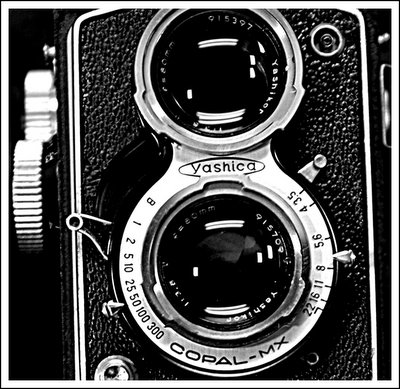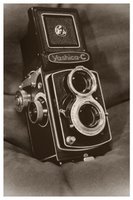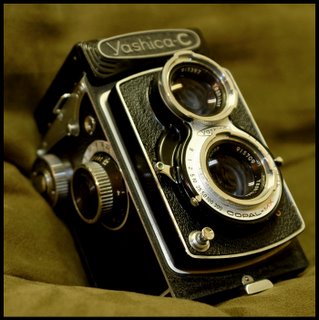
A few posts back I enthusiastically introduced my newest and most inexpensive camera thus far. With only 2 rolls of 120mm film under my belt, I'm still excited about shooting with my $19 Holga, but beyond the technical shortcomings of the plastic wonder, what was the deal with medium format film? I had previously read in a photography magazine that the wedding photography industry highly demanded nothing less than medium format film. Supposedly, the 35mm format could not compete with the higher resolution of 120mm medium format. The quality of enlargements with medium format film, amongst other advantages, is apparently still preferred over some of the most advanced digital cameras and 35mm films.
I had read enough. The Holga left me with a craving for film and high quality. It didn't take much time for me to decide that I wanted to try my hand at shooting something in the medium format range, but with a camera that had a higher quality
 lens. I figured that beyond a plastic lens, anything with glass had to be of better quality. Researching the perfect camera for my budget proved to be somewhat frustrating, but eventually my search ended with the Yashica series camera. Obtainable in the common price range of $45-$125 via eBay or through online consignment, the lettered Yashica series (A-D) proves to be the least expensive with the highest quality for my "beginner" status. Manufactured circa 1958, the Yashica C twins lens reflex (TLR) camera features a 3-element lens, shutter speeds "B" (bulb mode) to 1/300th of a second, and a flash sync connection. If I left you wondering what a 3-element lens is, have yourself a look at this FAQ - All about lenses. In a nutshell, the camera uses 3 pieces of glass to form the shooting lens. As you can already guess, the more glass used in a lens typically means the more expensive the lens or camera can become.
lens. I figured that beyond a plastic lens, anything with glass had to be of better quality. Researching the perfect camera for my budget proved to be somewhat frustrating, but eventually my search ended with the Yashica series camera. Obtainable in the common price range of $45-$125 via eBay or through online consignment, the lettered Yashica series (A-D) proves to be the least expensive with the highest quality for my "beginner" status. Manufactured circa 1958, the Yashica C twins lens reflex (TLR) camera features a 3-element lens, shutter speeds "B" (bulb mode) to 1/300th of a second, and a flash sync connection. If I left you wondering what a 3-element lens is, have yourself a look at this FAQ - All about lenses. In a nutshell, the camera uses 3 pieces of glass to form the shooting lens. As you can already guess, the more glass used in a lens typically means the more expensive the lens or camera can become. The first thing I found odd about medium format film cameras was the fact that there were 2 distinctly different styles of cameras. Unlike the typical single lens reflex (SLR) style of camera, the TLR camera uses a second (top) lens for viewfinding duties and a lower primary lens for exposing the film. Viewfinding is odd because everything appears backwards in the viewfinder. I had never seen anything like it before. Aside from the lower cost and unusual look of this camera, I found it to be more appealing in the sense that it looks vintage. I am curious to see what kind of looks I will get when I am out shooting.
I am hoping to go out shooting this weekend. I promise I will post some pictures soon. Until then, Happy New Year and keep your eyes open. You never know what you might see.

![[banner_spring09.jpg]](http://1.bp.blogspot.com/_IxW9pxRZGgw/SetdhfkCodI/AAAAAAAABBI/yZutqr7brFg/s1600/banner_spring09.jpg)
No comments:
Post a Comment